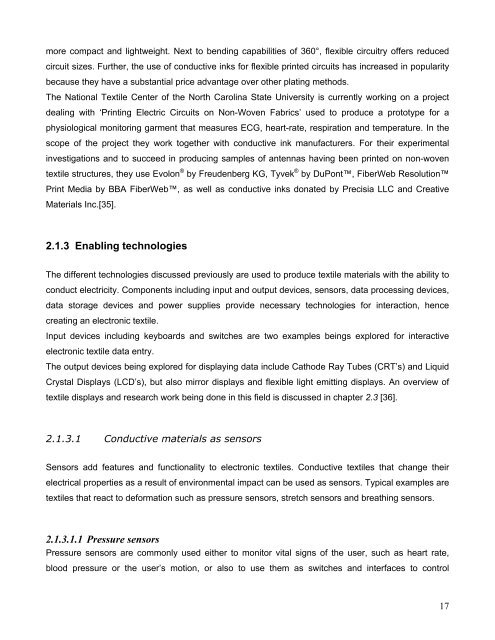Clevertex - Grado Zero Espace Srl
Clevertex - Grado Zero Espace Srl
Clevertex - Grado Zero Espace Srl
Create successful ePaper yourself
Turn your PDF publications into a flip-book with our unique Google optimized e-Paper software.
more compact and lightweight. Next to bending capabilities of 360°, flexible circuitry offers reduced<br />
circuit sizes. Further, the use of conductive inks for flexible printed circuits has increased in popularity<br />
because they have a substantial price advantage over other plating methods.<br />
The National Textile Center of the North Carolina State University is currently working on a project<br />
dealing with ‘Printing Electric Circuits on Non-Woven Fabrics’ used to produce a prototype for a<br />
physiological monitoring garment that measures ECG, heart-rate, respiration and temperature. In the<br />
scope of the project they work together with conductive ink manufacturers. For their experimental<br />
investigations and to succeed in producing samples of antennas having been printed on non-woven<br />
textile structures, they use Evolon ® by Freudenberg KG, Tyvek ® by DuPont, FiberWeb Resolution<br />
Print Media by BBA FiberWeb, as well as conductive inks donated by Precisia LLC and Creative<br />
Materials Inc.[35].<br />
2.1.3 Enabling technologies<br />
The different technologies discussed previously are used to produce textile materials with the ability to<br />
conduct electricity. Components including input and output devices, sensors, data processing devices,<br />
data storage devices and power supplies provide necessary technologies for interaction, hence<br />
creating an electronic textile.<br />
Input devices including keyboards and switches are two examples beings explored for interactive<br />
electronic textile data entry.<br />
The output devices being explored for displaying data include Cathode Ray Tubes (CRT’s) and Liquid<br />
Crystal Displays (LCD’s), but also mirror displays and flexible light emitting displays. An overview of<br />
textile displays and research work being done in this field is discussed in chapter 2.3 [36].<br />
2.1.3.1 Conductive materials as sensors<br />
Sensors add features and functionality to electronic textiles. Conductive textiles that change their<br />
electrical properties as a result of environmental impact can be used as sensors. Typical examples are<br />
textiles that react to deformation such as pressure sensors, stretch sensors and breathing sensors.<br />
2.1.3.1.1 Pressure sensors<br />
Pressure sensors are commonly used either to monitor vital signs of the user, such as heart rate,<br />
blood pressure or the user’s motion, or also to use them as switches and interfaces to control<br />
17

















